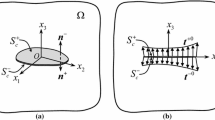Abstract
The mode I crack problem in plates under membrane loading and bending is reconsidered. The purpose is to examine certain analytical features of the problem further and to provide some new results. The formulation and the results given by the classical and the Reissner plate theories for through and part-through cracks are compared. For surface cracks the three-dimensional finite element solution is used as the basis of comparison. The solution is obtained and results are given for the crack/contact problem in a plate with a through crack under pure bending and for the crack interaction problem. Also, a procedure is developed to treat the problem of subcritical crack growth and to trace the evolution of the propagating crack.
Résumé
On considère la propagation dynamique en conditions stable de deux fissures parallèles semi-infinies de Mode III, dans un corps quelconque à visco-élasticité linéaire et à caractéristiques infinie, homogène et isotrope.
On suppose exister à l'extrémité de la fissure une zone de rupture de type Barenblatt et on tire une formulation pour la vitesse de relaxation de l'énergie, qui fournit des comparaisons immédiates avec le modèle correspondant pour une fissure simple.
On illustre par des calculs numériques l'influence de la vitesse de la fissure, de la distance séparant les fissures et des propriétés du matériau sur la vitesse de relaxation de l'énergie, dans le cas d'un matériau à comportement parabolique, et dans le cas d'un matériau linéaire standard.
Comme cas limites de l'analyse, on établit les résultats pour des problèmes élastiques et des problèmes visco-élastiques quasi-statiques.
Similar content being viewed by others
References
J.K. Knowles and N.M. Wang, Journal of Mathematics and Physics 39 (1960) 223–236.
R.J. Hartranft and G.C. Sih, Journal of Mathematics and Physics 47 (1968) 276–291.
N.M. Wang, Journal of Mathematics and Physics 47 (1968) 371–390.
M.B. Civelek and F. Erdogan International Journal of Fracture Mechanics 20 (1982) 33–46.
F. Delale and F. Erdogan, International Journal of Engineering Science 19 (1981) 1331–1340.
H. Boduroglu and F. Erdogan, ASME Journal of Applied Mechanics 50 (1983) 621–629.
F. Erdogan and H. Boduroglu, Theoretical and Applied Fracture Mechanics 2 (1984) 197–216.
E. Reissner, ASME Journal of Applied Mechanics 12 (1945) A69-A77.
E. Reissner, Quarterly of Applied Mathematics 5 (1947–1948) 55–68.
J.R. Rice and N. Levy ASME Journal of Applied Mechanics 39 (1972) 185–194.
J.R. Rice in The Surface Crack: Physical Problems and Computational Solutions, J.L. Swedlow (ed.) ASME New York (1972) 171–186.
J.C. Newman Jr. and I.S. Raju, “Analysis of Surface Cracks in Finite Plates Under Tension or Bending Loads”, NASA Technical Paper 1578 (1979).
D.P. Jones and J.L. Swedlow, International Journal of Fracture Mechanics 11 (1975) 897–914.
F.S. HemmingJr., International Journal of Fracture Mechanics 16 (1980) 289–304.
R.S. Alwar and K.N. Ramachandran Nambissan, Engineering Fracture Mechanics 17 (1983) 323–333.
A.C. Kaya and F. Erdogan, Quarterly of Applied Mathematics 45 (1) (1987) 105–122.
J.P. Benthem and W.T. Koiter, Methods of Analayis and Solutions of Crack Problems, G.C. Sih (ed.) Noordhoff International Publishing, Leyden, The Netherlands (1973).
A.C. Kaya and F. Erdogan, International Journal of Fracture Mechanics 16 (1980) 171–190.
B. Gross and J.E. Srawley, “Stress Intensity Factors for Single Edge Notch Specimens in Bending or Combined Bending and Tension by Collocation of a Stress Function”, NASA Technical Note D-2603 (1965).
H. Tada, P.C. Paris and G.R. Irwin, The Stress Analysis of Cracks Handbook, Del Research Corporation, Hellertown, Pa. (1973).
P.F. Joseph and F. Erdogan, “Plates and Shells Containing a Surface Crack Under General Loading Conditions”, NASA Contractor Report 178323, NASA Langley Research Center (July 1987).
M.L. Williams, ASME Journal of Applied Mechanics 28 (1961) 78–82.
R.W. Alwar and K.N. Ramachandran Nambissan, International Journal for Numerical Methods in Engineering 19 (1983) 293–303.
I.S. Raju, Private communication, Oct. 1987.
J.P. Benthem, International Journal of Solids and Structures 16 (1980) 119–130.
J.P. Benthem, International Journal of Solids and Structures 13 (1977) 479–492.
Z.P. Bazant and L.F. Estenssoro, International Journal of Solids and Structures 15 (1979) 405–426.
Author information
Authors and Affiliations
Additional information
This work was supported by NSF under the Grant MSM-8613611 and by NASA-Langley under the Grant NAG-1-713.
Rights and permissions
About this article
Cite this article
Joseph, P.F., Erdogan, F. Surface crack problems in plates. Int J Fract 41, 105–131 (1989). https://doi.org/10.1007/BF00018480
Received:
Accepted:
Issue Date:
DOI: https://doi.org/10.1007/BF00018480




